
London United Tramways Company Limited was an operator of trams and trolleybuses in the western and southern suburbs of London, UK, from 1894 to 1933, when it passed to the London Passenger Transport Board.

London United Tramways Company Limited was an operator of trams and trolleybuses in the western and southern suburbs of London, UK, from 1894 to 1933, when it passed to the London Passenger Transport Board.
The company was formed in 1894 by the Imperial Tramways Company under the leadership of George White and Clifton Robinson to take over the assets of the West Metropolitan Tramways Company, which had gone into receivership and had operated a horse-drawn tram service from Shepherd's Bush to Acton and Chiswick, and from Hammersmith to the north side of Kew Bridge via Chiswick. A short route ran from the south side of Kew Bridge to Richmond.

LUT relaid the existing track, which was in a poor state of repair, and extended and electrified the system. Electric trams first ran on three routes on 4 April 1901 between Hammersmith and Kew Bridge, between Shepherd's Bush and Kew Bridge (via Chiswick), and between Shepherd's Bush and Acton, London's first electric tram service.

Trams never ran across Kew Bridge – the second (stone) bridge, built in the 1780s, was far too narrow, and very steep on the approach from Brentford – which meant that there was an isolated length of single track of 1.53 miles, with passing loops, from the south side of the bridge, across Kew Green, then south along the Kew Road to the Orange Tree public house 51°27′51″N0°18′06″W / 51.464228°N 0.301534°W in Richmond.
LUT made repeated attempts to cross Kew Bridge after it was rebuilt in 1903 but these continued to be resisted by the Richmond Corporation Tramways Committee. Kew Road residents opposed two attempts in 1897 and 1898 to install a second track – which would have necessitated road widening – and any subsequent electrification using unsightly overhead wires seemed out of the question, locals favouring the underground conduit system. Kew Observatory had concerns about the introduction of electric trams.
So whilst the rest of London went electric, this little branch continued to use horse-drawn cars until well into the 20th century – the interiors had red velvet seat cushions and were described as "comfortable, if not luxurious", and ran every quarter-hour (the full "end to end" journey costing 2d) – until 20 April 1912 after which it was replaced by part of a London General (LGOC) motor-bus route.
Richmond's tram-shed still exists as the former RACC Shaftesbury Centre in Kew Road, now part of The Falcons School for Boys, just north of the A316.

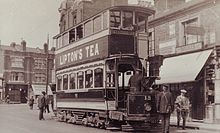
The LUT system was connected to the London County Council tram network at Hammersmith in 1908, Tooting in 1922 and Wandsworth in 1931; and to the Metropolitan Electric Tramways (MET) at Acton in 1909.
The company's headquarters, depot and power station were in Chiswick. On 1 January 1913, LUT became a subsidiary of the London and Suburban Traction Company (LSTC), jointly owned by the Underground Group and British Electric Traction. LSTC also owned the other two tramway companies in the London area, Metropolitan Electric Tramways and South Metropolitan Electric Tramways. [1]
| London United Tramways Act 1930 | |
|---|---|
| Act of Parliament | |
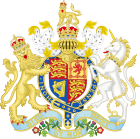 | |
| Long title | An Act to authorise the London United Tramways Limited to provide services of trolley vehicles and to abandon their tramways and light railways to confer upon them additional powers and for other purposes. |
| Citation | 20 & 21 Geo. 5. c. clxxxvii |
| Dates | |
| Royal assent | 1 August 1930 |
| Text of statute as originally enacted | |
The London United Tramways Act 1930 (20 & 21 Geo. 5. c. clxxxvii) gave it powers to replace loss-making tram routes with trolleybuses. London's first trolleybus service started on LUT's Twickenham to Teddington section on 16 May 1931 and then to Wimbledon, working from Fulwell Garage. These first trolleybuses, nicknamed "Diddlers", which lasted until replaced in 1948, bore a striking frontal resemblance to the 'Feltham' trams, also built around this period.
On takeover by the LPTB on 1 July 1933, London United had approximately 29 miles (47 km) of tram track, 18 of trolleybus route.

Only one LUT tramcar survives to the present day: no. 159, which has been restored to original condition and operates at the National Tramway Museum, Crich, Derbyshire.
Records related to London United Tramways can be found at Bristol Archives within the papers of George White (Ref. 35810/LUT) (online catalogue). Further records can be found at London Metropolitan Archives [2] and the National Tramway Museum [3]

The London Borough of Hounslow is a London borough in west London, England, forming part of Outer London. It is governed by Hounslow London Borough Council.

Isleworth is a suburban town in the London Borough of Hounslow, West London, England.

The Metropolitan District Railway, also known as the District Railway, was a passenger railway that served London, England, from 1868 to 1933. Established in 1864 to complete an "inner circle" of lines connecting railway termini in London, the first part of the line opened using gas-lit wooden carriages hauled by steam locomotives. The Metropolitan Railway operated all services until the District Railway introduced its own trains in 1871. The railway was soon extended westwards through Earl's Court to Fulham, Richmond, Ealing and Hounslow. After completing the inner circle and reaching Whitechapel in 1884, it was extended to Upminster in Essex in 1902.
There have been two separate generations of trams in London, from 1860 to 1952 and from 2000 to the present. There were no trams at all in London between 1952 and 2000.

Gunnersbury is an interchange station in Gunnersbury, London, situated on the District line of the London Underground and the Mildmay line of the London Overground. The station is located off Chiswick High Road (A315) and opened on 1 January 1869.

South Acton is a station on the Mildmay line of the London Overground, situated in South Acton in the London Borough of Ealing. It is in Travelcard Zone 3. Until 1959 it was also served by the District line of the London Underground.

Kew Bridge railway station is a railway station in Brentford, the London Borough of Hounslow, and is in Travelcard Zone 3. The station and all trains serving it are operated by South Western Railway. The station was named after the nearby Kew Bridge.
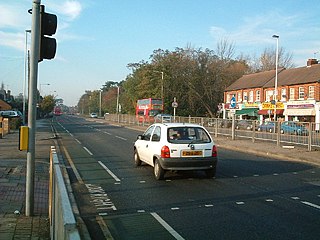
The West London Tram was a proposed on-street light rail line that was to run along the Uxbridge Road (A4020) corridor in West London, England. The scheme was promoted by Transport for London (TfL). It was postponed indefinitely on 2 August 2007, as it was opposed by the councils of all three bisected London Boroughs.
Metropolitan Electric Tramways Limited (MET) operated electric tram services in suburban areas of Middlesex and Hertfordshire from 1904 to 1933, when its services passed to the London Passenger Transport Board.

Fulwell Bus Garage is a Transport for London bus garage located in Twickenham in west London. It is north of Fulwell railway station and operates as two halves, with entrances on the A311 Wellington Road and B358 Stanley Road. It is currently operated by Transport UK London Bus and London United.

RATP Dev Transit London Limited, trading as RATP Dev Transit London, is a bus company operating mostly in west and south-west Greater London. The London United brand is a subsidiary of RATP Dev Transit London and operates services under contract to Transport for London.

Fulwell is a neighbourhood of outer South West London in the London Borough of Richmond upon Thames. It straddles the west of the "ancient" parish and urban district borders of Twickenham and Teddington. The name is first known in documents of the fifteenth century. It may be from a reliably full well or a corruption of foul well. Until 1965, Fulwell was in the historic County of Middlesex.
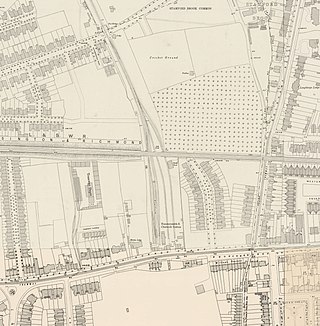
Hammersmith & Chiswick was a railway terminus in west London that was opened in 1858 by the North & South Western Junction Railway and closed in 1917, during the First World War.
The North and South Western Junction Railway (NSWJR) was a short railway in west London, England. It opened in 1853, connecting Willesden on the London and North Western Railway (LNWR) with Brentford on the London and South Western Railway (LSWR). After a difficult start it became an important freight route and that usage continues today. A passenger service linked LSWR stations with the North London Railway, and a branch was built to Hammersmith.
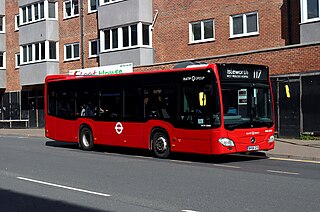
London Buses route 117 is a Transport for London contracted bus route in London and Surrey, England. Running between West Middlesex University Hospital and Staines-upon-Thames, it is operated by RATP Dev Transit London.

Trolleybuses served the London Passenger Transport Area from 1931 until 1962. For much of its existence, the London system was the largest in the world. It peaked at 68 routes, with a maximum fleet of 1,811 trolleybuses.
Llanelly and District Electric Tramways operated a standard gauge tramway service in Llanelli, Wales, between 1908 and 1933. It was the successor to a 3 ft gauge horse tramway, which ran from 1882 until 1908. A complex series of negotiations took place in the early 1900s, resulting in the horse tramway being converted to an electric tramway. Standard gauge horse trams were run initially, until the company completed North Dock power station, which supplied electricity to the tramway. Two of the employees who worked on the construction went on to found Balfour Beatty.

This article deals with the development of the London suburban railway lines of the London and South Western Railway (LSWR). For the wider view of the LSWR in general, see London and South Western Railway.
London's last tram week refers to the last full week of operation of London's first-generation street tram system, from 29 June to 5 July 1952. It was the culmination of a three-year programme, known as Operation Tramaway, that saw the replacement of south London's entire tram network with a fleet of modern diesel buses, at a cost of £10 million. The trams had been very popular among Londoners, and in south London they accounted for the majority of local journeys by public transport. Many people regarded their demise as a particularly momentous event. On the last day of operation, large crowds gathered to see the last trams in service and to take a final ride. On arrival at its depot, the very last tram was ceremoniously received by a group of dignitaries, watched by a large number of spectators.
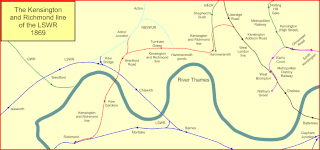
The Kensington and Richmond line was a railway in West London, England. It was built by the London and South Western Railway, which already had a main line to Richmond from London. The Kensington line was chiefly a defensive measure to limit the incursion of rival railways into LSWR territory. It ran from Kensington on the West London Railway, by way of Hammersmith, Turnham Green, Gunnersbury and Kew; it opened in 1869. It had a separate station at Richmond, in keeping with the LSWR intention of preventing competitors from easily obtaining running powers to go further into the LSWR area.